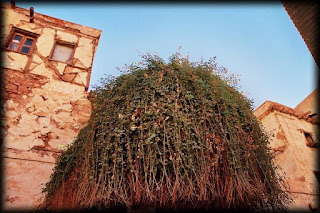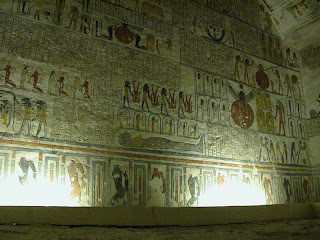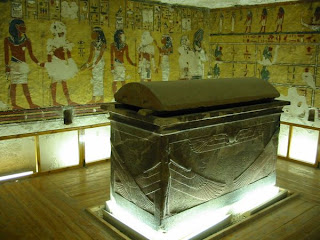Days 74-75, September 28-29, 2008

Early in the morning after our day in Newaba, we drove to the ferry station on the Sinai to depart Egypt. The ferry ride was about an hour across the Gulf of Aqaba at the north end of the Red Sea. When you are crossing the sea, you can look around you and see the coasts of 4 countries: Egypt, Israel, Jordan, and Saudi Arabia. After I visit Israel next week, I will never be allowed to enter Saudi Arabia due to supporting a false Zionist state so this is probably the closest I’ll ever get to there. The city of Aqaba occupies most of the short Jordanian coast on the Red Sea and this is where we both entered Jordan and spent the next day and night.


Most of our time in Aqaba was free-time so it was spent walking around and taking the city in. The first thing that you notice when you enter Jordan is that it is noticeably cleaner than Egypt, which as I mentioned before, is a dirty place. Jordan is one of the few mid-east countries that has no oil or significant natural resources and they have prospered despite this disadvantage. When the Middle Eastern oil has dried up, Jordan has set itself up to survive through investments in education and business. They have used their strong economy to build and beautify their country. In Aqaba, everything looks new, is painted, and it has several gardens to contrast the desert that occupies about 80% of the country.

The other noticeable difference between Egypt and Jordan is that Jordan actually has good food. I don’t think that I commented too much on the food in Egypt before and, while it is edible, on a whole, it is very bland and hard on the palate. In my two days in Jordan so far, I have had some of the best food that I have had on my entire trip. OK, well maybe not the entire trip…I have eaten well my entire time abroad, but the food has been excellent nonetheless.
My first morning in Jordan was a big morning for me. I decided to shave my moustache. It was fun while it lasted but I can say without any doubt that I will never wear one again as long as I live. I thought that it looked ridiculous. For everyone in my group, though, that is the only way that they had ever known me so I received a myriad of reactions throughout the morning when they saw me clean shaven. My room mate, Brett, jumped back and asked, “what’d you do with David?” One of the girls, Larissa, gave gasp as if someone just punched her in the stomach. A few people, though, didn’t even notice anything until the next day when I caught them staring at me a little too long and I could tell that they couldn’t quite figure out what was different. Then I put my finger across my lip and they busted out laughing. Several people have told me that I look 5-10 years younger without it. I am happy to look 21 again.
Our second day in Jordan, we drove up to the desert of Wadi Rum which is about and hour and a half north of Aqaba. For our night in Wadi Rum, we stayed in a Bedouin community. It is a collection of tents tucked into a natural shelter created by a rocky mountain.

I never realized how beautiful the desert could be. We took a four hour jeep ride through it and were able to see some beautiful rock formations, colors, and a spectacular sunset. At our sunset location, a few of us hiked up a hill to get some amazing pictures and an even more amazing view.







When we got back to the campsite, it was dark and we ate a traditional Bedouin meal of lamb and potatoes. They cook it in the ground for several hours. The only thing that the meal was missing was a few cold beers. It was the last night of Ramadan and our hosts are very observant of the no alcohol during Ramadan policy. Since Ramadan ends with the new moon, we had a pitch black night by which to see the stars. After the singing and dancing around the campfire ended, most of us found a comfortable spot and kicked back to see a view of the starry sky that only the desert can offer.


The intrigue also began this night. Our guide, Khaleid, disappeared from the camp and no body knew where he went. One of the Bedouins, who spoke English, finally told us that Khaleid was in the hospital because he had become very sick. I knew that he wasn’t feeling well. You could tell that by just watching him but nobody knew he was that sick. All 15 of us went to bed that night, in the middle of the desert, not knowing if we had a guide for the rest of our stay in Jordan. I don’t think that it made anybody sleep any worse but it was in the back of everyone’s mind.
Early in the morning after our day in Newaba, we drove to the ferry station on the Sinai to depart Egypt. The ferry ride was about an hour across the Gulf of Aqaba at the north end of the Red Sea. When you are crossing the sea, you can look around you and see the coasts of 4 countries: Egypt, Israel, Jordan, and Saudi Arabia. After I visit Israel next week, I will never be allowed to enter Saudi Arabia due to supporting a false Zionist state so this is probably the closest I’ll ever get to there. The city of Aqaba occupies most of the short Jordanian coast on the Red Sea and this is where we both entered Jordan and spent the next day and night.
Most of our time in Aqaba was free-time so it was spent walking around and taking the city in. The first thing that you notice when you enter Jordan is that it is noticeably cleaner than Egypt, which as I mentioned before, is a dirty place. Jordan is one of the few mid-east countries that has no oil or significant natural resources and they have prospered despite this disadvantage. When the Middle Eastern oil has dried up, Jordan has set itself up to survive through investments in education and business. They have used their strong economy to build and beautify their country. In Aqaba, everything looks new, is painted, and it has several gardens to contrast the desert that occupies about 80% of the country.
The other noticeable difference between Egypt and Jordan is that Jordan actually has good food. I don’t think that I commented too much on the food in Egypt before and, while it is edible, on a whole, it is very bland and hard on the palate. In my two days in Jordan so far, I have had some of the best food that I have had on my entire trip. OK, well maybe not the entire trip…I have eaten well my entire time abroad, but the food has been excellent nonetheless.
My first morning in Jordan was a big morning for me. I decided to shave my moustache. It was fun while it lasted but I can say without any doubt that I will never wear one again as long as I live. I thought that it looked ridiculous. For everyone in my group, though, that is the only way that they had ever known me so I received a myriad of reactions throughout the morning when they saw me clean shaven. My room mate, Brett, jumped back and asked, “what’d you do with David?” One of the girls, Larissa, gave gasp as if someone just punched her in the stomach. A few people, though, didn’t even notice anything until the next day when I caught them staring at me a little too long and I could tell that they couldn’t quite figure out what was different. Then I put my finger across my lip and they busted out laughing. Several people have told me that I look 5-10 years younger without it. I am happy to look 21 again.
Our second day in Jordan, we drove up to the desert of Wadi Rum which is about and hour and a half north of Aqaba. For our night in Wadi Rum, we stayed in a Bedouin community. It is a collection of tents tucked into a natural shelter created by a rocky mountain.
I never realized how beautiful the desert could be. We took a four hour jeep ride through it and were able to see some beautiful rock formations, colors, and a spectacular sunset. At our sunset location, a few of us hiked up a hill to get some amazing pictures and an even more amazing view.
When we got back to the campsite, it was dark and we ate a traditional Bedouin meal of lamb and potatoes. They cook it in the ground for several hours. The only thing that the meal was missing was a few cold beers. It was the last night of Ramadan and our hosts are very observant of the no alcohol during Ramadan policy. Since Ramadan ends with the new moon, we had a pitch black night by which to see the stars. After the singing and dancing around the campfire ended, most of us found a comfortable spot and kicked back to see a view of the starry sky that only the desert can offer.
The intrigue also began this night. Our guide, Khaleid, disappeared from the camp and no body knew where he went. One of the Bedouins, who spoke English, finally told us that Khaleid was in the hospital because he had become very sick. I knew that he wasn’t feeling well. You could tell that by just watching him but nobody knew he was that sick. All 15 of us went to bed that night, in the middle of the desert, not knowing if we had a guide for the rest of our stay in Jordan. I don’t think that it made anybody sleep any worse but it was in the back of everyone’s mind.



